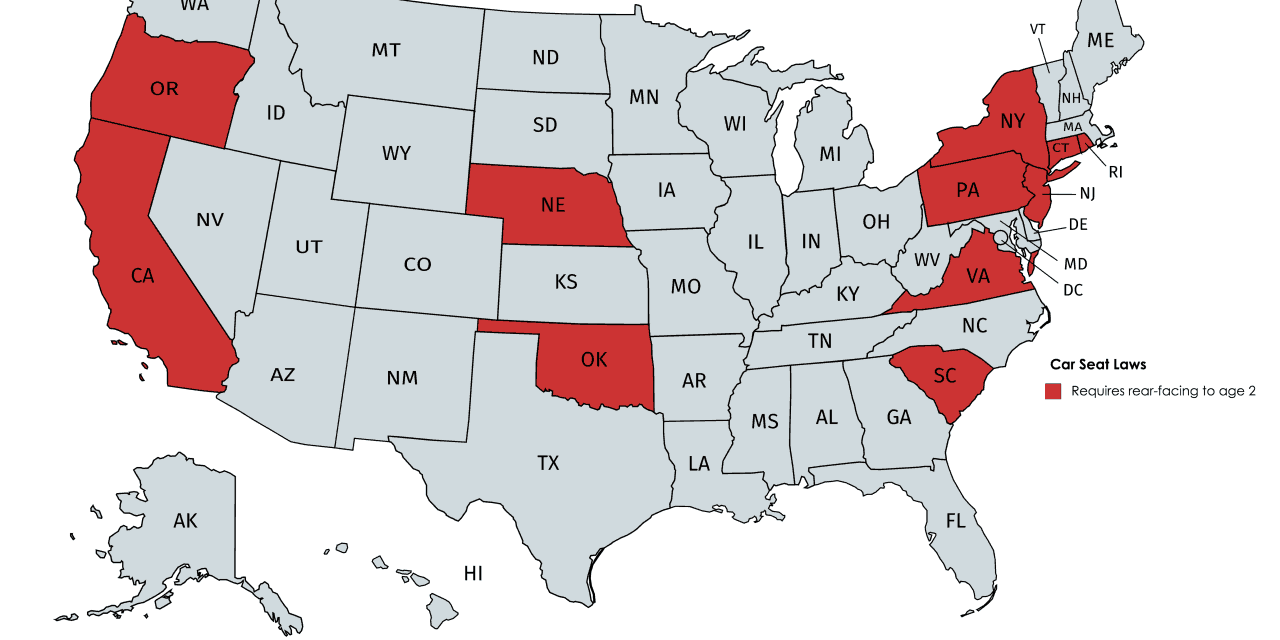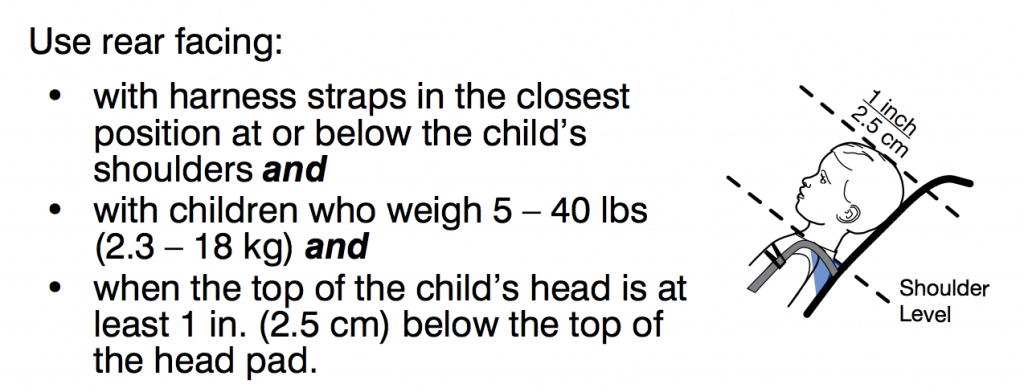Map above shows states which have enacted rear-facing to age 2 laws as of September 2018. Illinois recently enacted a new law that will take effect in 2019.
5 Unanswered Questions about the AAP’s New 2018 Car Seat Policy
5 Unanswered Questions about the AAP’s New 2018 Car Seat Policy. Published: . The American Academy of Pediatrics revised its car seat policy last month, saying children should stay rear-facing as long as possible—to the limits of the seat.
Previously, the pediatric group recommended rear-facing to age 2 or the limits of the seat. The part most folks remember is the rear-facing to age 2 guideline.
While the difference is subtle, the new policy raises a series of questions that parents, lawmakers and car seat makers will soon face. Here’s a rundown:
1. Will the new policy confuse parents and caregivers?
The previous 2011 AAP policy was quite clear: keep kids rear-facing until at least age 2.
The new policy removes that age guidelines and says to keep kids rear-facing until they max out the limits of the seat.
Sounds simple, right? Yet here are the instructions for one popular seat (the Britax Marathon) on rear-facing use:
To translate that to understandable English, Britax is saying that IF your child doesn’t meet ANY of those conditions, you must NOT face your child to the rear of the vehicle.
In other words, for example, even if your child is under 40 lbs, they must be turned around to forward-facing if the top of your child’s head is within an inch of the top of the seat (head pad).
Piece of cake?
The truth is the majority of parents don’t look at the car seat’s manual—so the subtleties of these rules might go unheeded.
“The new AAP policy will muddy the waters,” a veteran car seat passenger safety tech told us at a safety conference last week.
We would agree: clear, easy-to-understand guidelines are best. We’ll have to see what happens in the real world with the new AAP guidelines, but it fails the “keep it simple” test, in our opinion.
2. Is extended rear-facing really safer for kids aged 3, 4, 5 and beyond?
While it is clear from safety data (both accident data and laboratory testing) that kids are safer when riding rear-facing under age 1, the data beyond age 1 is inconclusive, at best.
That’s not just our opinion. At a conference on car seat safety last week, the American Academy of Pediatrics spokesperson Dr. Benjamin Hoffman dropped a bombshell when he told attendees “there is no science” behind the rear-facing recommendation from age one to age two.
In our opinion, American Academy of Pediatrics damaged its own credibility when it billboarded a study claiming that rear-facing from ages 1 to 2 was FIVE TIMES safer that forward-facing. Turns out the ONE study this assertion was based on was bogus—it was retracted by its authors and the journal that published it.
We are not academic researchers or policy makers, but relying on a SINGLE STUDY to base a new car seat policy that could impact millions of children (as the AAP did) is the definition of recklessness. (And then to double down, the American Academy of Pediatrics turned to some of the study’s initial authors to “reassess” their retracted paper. In what world does that happen?).
The most charitable way to view the ongoing debate whether extended rear-facing is safer for older children is to say the science is evolving.
We know car seats save lives. The number of kids under 15 killed or seriously injured in vehicle crashes declined by 45% from 1999 to 2008. While quite a few factors figured into that reduction, better car seats (and increased usage) clearly helped.
Yet car crashes are still the leading cause of death for children. So the best way to protect kids in car seats is an important debate.
Here’s what is happening behind the scenes: there is a tug of war between safety advocates as to whether extended rear-facing car seat use is safer.
As you can tell from recent events, extended rear-facing advocates are winning the war. Yet some critics point out the scientific evidence to justify this (rear-facing beyond age 1 much less 2 and beyond) is thin at best.
And rushing out extended rear-facing guidelines could be dangerous if the car seats aren’t ready—or if we discover rear-facing for kids aged 3 and up is actually MORE dangerous than forward-facing, based on interactions with other elements in a vehicle (front seats, etc). We simply don’t know . . . so should we gamble?
We have been long time proponents of extended rear-facing especially to age 1 and perhaps age 2—when we started out writing about car seat safety in the 1990’s, few seats went beyond 20 lbs. rear-facing.
But the new AAP guidelines could lead more parents to keep kids rear-facing way beyond that. And even proponents of extended rear-facing admit there is a lack of scientific evidence to justify keeping kiddos rear-facing to age 3, 4 and beyond.
3. Are car seats ready for this new rule?
Most convertible car seats sold today have rear-facing limits of about 40 lbs.—some even go to 50 lbs. Or so they claim.
Yet, here is an inconvenient truth: the government doesn’t safety test these seats in rear-facing mode beyond 22 lbs., which represents a one-year old child.
What we are referring to here is “compliance testing.” When a car seat maker readies a safety seat for sale, they do crash tests at a government approved lab and then report these results to the government. This “self-certification” is part of a car seat’s approval process.
Yet the government also does independent testing—called “compliance testing.” Here, the government takes a car seat in production and crash tests it to make sure it complies with federal safety standards.
When it comes to compliance testing, the federal government simply doesn’t do it beyond 22 lbs. for rear-facing convertible seats. To us, that is a huge safety failure. Yes, a car seat maker like Graco or Britax can say their seats meet those weight limits—but there is no independent check by safety regulators.
4. Do today’s car seats have the technology to keep kids safe when rear-facing beyond age 3?
Here’s an open question: do today’s convertible car seats have the technology to keep kids safe rear-facing beyond age 2 or 3?
The main concern here for older children riding rear-facing is rotation during a crash. As a child gets heavier with age, there is more rotation in a seat during a crash. Here’s a Britax infant seat in a rear-facing crash—notice how the seat rotates to strike the back of the back seat:
At the same car seat conference we attended in late August, Dorel showed a Cosco Apt in both forward and rear-facing crash tests—the rear-facing crash test showed a much greater chance of head injury to a one-year old child when rear-facing compared to forward facing. That was with a 22 lb. dummy (we asked Dorel for permission to show this video here, but haven’t heard back as of press time).
Now that was one crash test with one seat, which was not installed with any of the advanced safety features available in some convertibles today (rigid LATCH, etc). What about other seats? We just don’t have the answers. But a lack of data doesn’t justify new guidelines.
We do know that existing technologies like load legs and European belt routing do limit rotation of a seat in an accident. Here’s a video of a load leg of the Cybex Aton 2 at work:
So how many convertible car seats now on the market in the US have load legs? Zero.
Part of this is due to outdated federal safety crash test rules that don’t allow manufacturers to certify seats with load legs—that’s because the federal government crash test bench doesn’t have a floor. Yet they are common in other parts of the world, such as Europe.
Ditto for European belt baths (see more on this here). Some infant car seats allow European belt path routing, but how many CONVERTIBLE car seats have this as of today? That would be zero. Again.
We realize that sometimes groups like the American Academy of Pediatrics change safety rules in order to encourage the market to come up with new products that can meet the challenge.
But is it dangerous to give guidance that promotes rear-facing seat use to ages 3, 4, 5 and 6 without the car seats having technology to keep kids safe today? We can hope the technology comes online some day . . . but how does that help today’s kiddos?
5. Should states that enacted rear-facing to age 2 laws ticket parents for correctly using a seat?
Eleven states now require children younger than two to be in a rear-facing car seat.
Those states are CA, CT, NE, NJ, NY, OK, OR, PA, RI, VA and SC. (Illinois just enacted a new law that will take effect in 2019). Note that most of these states passed laws BEFORE it was revealed the study this was based on was retracted.
Now that we know “there is no science” behind the rear-facing recommendation from age 1 to 2 (as the American Academy of Pediatrics spokesperson stated in a car seat conference in late August), should these states actually hand out tickets to parents who have turned a 20 month old toddler around to face forward in a convertible car seat?
Think about that—according to most car seat manufacturer’s instructions, a 20 month old toddler who is more than 20 lbs. can ride EITHER forward or rear-facing in most convertible car seats. The car seat maker considers both to be an appropriate AND safe use of the seat.
Yet these same parents now face a ticket, which incurs a fine, court costs and demerits to their driver license (depending on the state) for turning their toddler around before the age of 2.
We realize the arbitrary use of age limits is the only way to reasonably enforce a state law—police and troopers aren’t going to be measuring children’s height and weight road-side to see if parents are truly complying with car seat safety guidelines.
But until scientific evidence actually confirms rear-facing from age 1 to 2 is safer, why should states punish parents for turning around a toddler older than one but younger than two?
Doesn’t this conflict with our complaint about the guidelines now being more vague than the “before age 2” rules? No—making recommendations to parents as clear as possible is a laudable goal, but criminally punishing parents for using a car seat in a manner the manufacturer deems safe is another kettle of fish.
No state should criminally punish a parent for that, in our opinion.
What do you think about the new car seat guidelines? Weigh in below.



 We obsess over gear for families and the home . . . so you don’t have to. Baby Bargains has one mission: help you find the best gear for your family with unbiased reviews by experts with 20 years of experience. At prices that don’t break the bank. When you purchase a product from links on this site, we make a small affiliate commission. Learn more
We obsess over gear for families and the home . . . so you don’t have to. Baby Bargains has one mission: help you find the best gear for your family with unbiased reviews by experts with 20 years of experience. At prices that don’t break the bank. When you purchase a product from links on this site, we make a small affiliate commission. Learn more 
